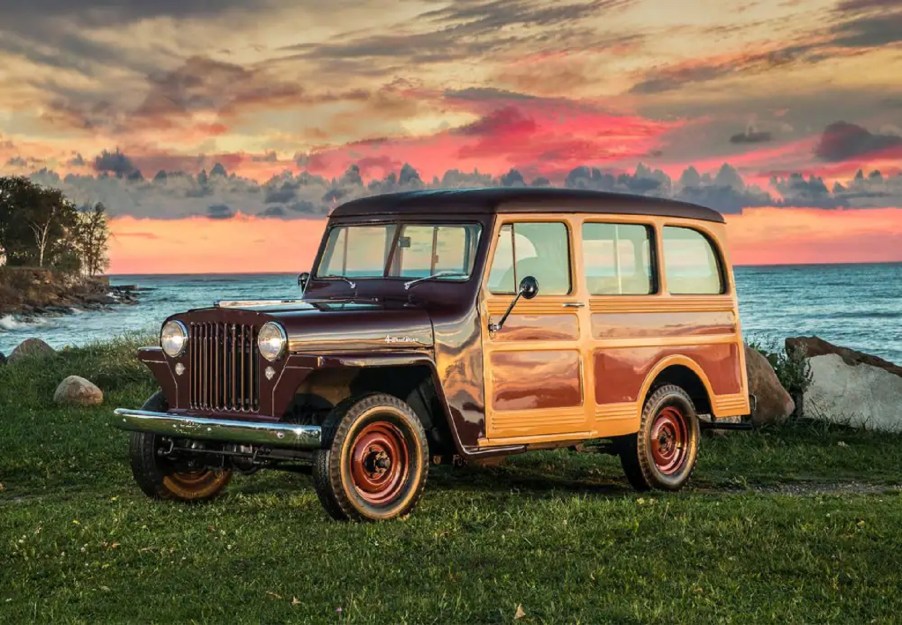
Willys-Overland Station Wagon: The True Luxury SUV Ancestor
Despite their modern ubiquity, SUVs as a named segment didn’t really exist until the 1970s. But they didn’t just spring up out of nowhere. Track the SUV lineage back far enough and you wind up at the station wagon. Even fancy luxury SUVs like the Rolls-Royce Cullinan wouldn’t exist without it. More specifically, they wouldn’t exist without the Willys-Overland Station Wagon.
Like the Jeep Grand Wagoneer? You can thank the Willys-Overland Station Wagon

Although some argue that the original Range Rover was the first ‘true’ luxury SUV, that’s not strictly true, Hagerty says. The Jeep Super Wagoneer, the original Grand Wagoneer’s precursor, debuted in 1966, four years before the first Range Rover. And its predecessor was the 1946 Willys-Overland Station Wagon.
The Willys Wagon, as it’s often called, wasn’t the first station wagon. And with its all-steel body that merely mimicked wood panels, it stood apart from earlier wagons. But this construction method, designed so appliance factories could easily stamp the panels—because other factories were busy—was a wagon first. And the other Willys-Overland Station Wagon features laid the groundwork for the modern luxury SUV. Also, fun fact: the original Wagoneer’s designer, Brooks Stevens, also designed this wagon.

While the Station Wagon was the second post-war vehicle Willys-Overland released after the original CJ, it didn’t initially have 4WD. However, it did have the same 63-hp 2.2-liter ‘Go Devil’ four-cylinder engine and three-speed transmission. Also, the first production fold-down tailgate as well as seating for seven.
In addition, except for the driver’s seat, those seats are removable. And speaking of the interior, it’s fully washable, as in the modern Wrangler. Plus, with 96 cubic feet of possible storage, it has more cargo space than some modern SUVs. Hence why Willys also offered the Wagon in panel-van form. And while it didn’t initially have 4WD, the Station Wagon was the first Willys-Overland product with independent front suspension. The 2WD models kept their IFS setups until 1955 when solid axles became standard, Hemmings reports.
Even today, with some choice mods, a Willys-Overland Station Wagon is a capable classic off-roader
While it lacked 4WD at first, Willys-Overland made it optional in 1949, solidifying its SUV precursor status, Hagerty notes. Technically, the 4WD version is the ‘Utility Wagon’ while the 2WD one is the ‘Station Wagon,’ but both are called ‘Willys Wagon’ today. And over the next 16 years, Willys-Overland, later Willys-Jeep, and then just ‘Jeep,’ tweaked and upgraded the wagon.
Unfortunately, by the mid-1960s, the Willys Wagon was facing increasing pressure from other station wagons/proto-SUVs like the Chevrolet Suburban. And while the Wagon had the 105-hp 3.7-liter ‘Super Hurricane’ six-cylinder engine and overdrive on its three-speed manual at this point, its age was clearly showing. So, in 1965, Jeep replaced it with the Wagoneer, leading to the Grand Wagoneer and, eventually, their modern incarnations.
However, with a few upgrades, the Willys-Overland Station Wagon still makes a solid workhorse. Owners regularly modify them for off-road rallies, Hagerty says, including the brutal King of the Hammers. And in-period, they were often converted into camper vans. But even in stock form, these Wagons are surprisingly comfortable—if utilitarian—and easy to drive, Hemmings reports. They’re also simple to work on. And while they don’t have many luxuries, later models do have a clever traffic-light reflector for spotting awkwardly-placed stoplights, The Drive explains.
Plus, for those who want a bit more go than the Go-Devil provides, there’s always the restomod option. Land Cruiser expert Icon, for example, once restomodded a 1960 example. Jeep itself built a Willys-Overland Station Wagon restomod several years ago, too. And at least one owner swapped in a 6.1-liter Hemi V8, The Drive says. So, the SUV’s grandparent has some life left in them yet.
It’s cheaper than a classic Grand Wagoneer
Although it was outdated by the 1960s, the Willys-Overland Station Wagon was one of the brand’s most popular models. Willys sold over 300,000 Wagons during the car’s production run. So, it’s not exactly rare.
And though it’s less luxurious than the later Grand Wagoneers, the Wagon is also less expensive. A late-model good-to-excellent-condition example typically runs from $20K-$30K, Hagerty claims. And while Willys Wagon values benefit from modern engine swaps, unless you’re going to Icon, you’ll still likely pay sub-Wagoneer prices.
Not bad for a piece of SUV history.
Follow more updates from MotorBiscuit on our Facebook page.


